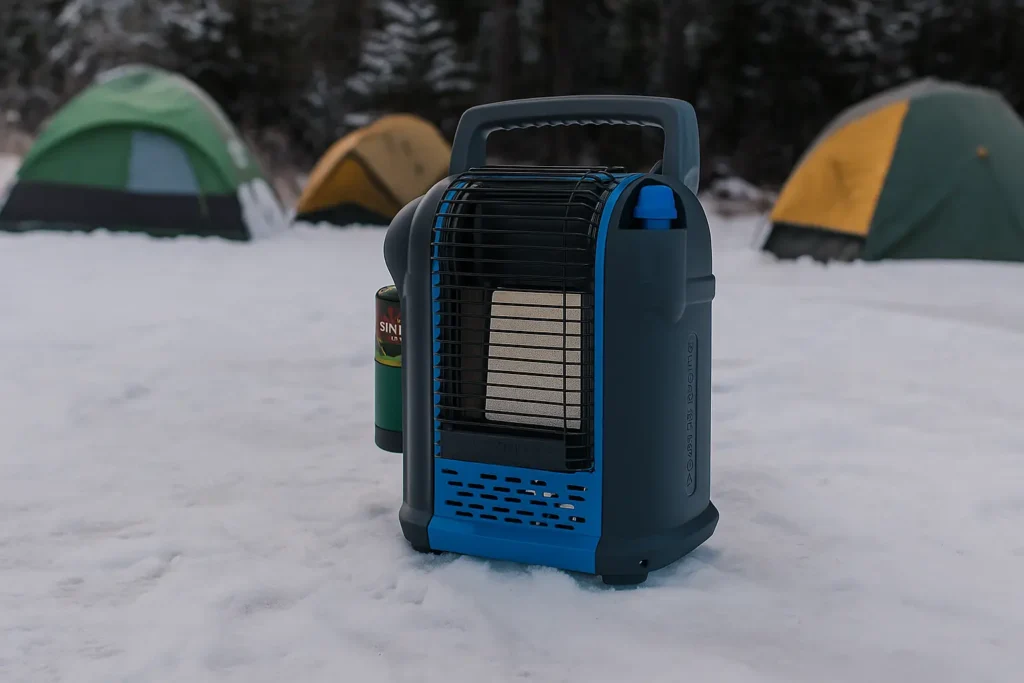Why Portable Heaters Matter in Cold Camping
When temperatures plunge at night, even a 4‑season tent or warm sleeping bag sometimes falls short. A portable heater adds comfort and dramatically improves sleep quality by maintaining warmth where needed. But indiscriminate use can pose serious safety risks.
Key Features to Consider
-
Fuel Type & Heat Output
- Propane radiant heaters deliver 3,800–9,000 BTU and can heat 100–225 sq ft — ideal for tents, RVs, and porches.
- Catalytic heaters (flameless) offer lower emissions and longer runtime on small cylinders—good for windy nights.
-
Safety Systems
- Look for tip‑over shutoff, and oxygen depletion sensors (ODS) that automatically turn off when oxygen is low.
- CSA or ASTM certification is a plus.
-
Runtime & Fuel Efficiency
- A 1 lb propane canister typically lasts 2–3 hours on high or up to 5 hours on low for models like Mr. Heater Buddy.
-
Portability & Stability
- Compact footprint, carrying handle, stable base are essential—especially for backpackers.
-
Indoor (Tent/RV) Safe Use
- Only use propane heaters rated for indoor or enclosed-terrain safe applications like Mr. Heater Buddy and Little Buddy.
-
Other Considerations
- Altitude performance (some will shut off above ~7,000 ft).
- Noise (fan vs radiant), heat distribution, and optional features like cooking stoves.
When choosing a heater for cold-weather camping, a few key technical aspects can make all the difference. Start with the fuel type and heat output—most campers opt for propane radiant heaters that can deliver anywhere from 3,800 to 9,000 BTU, enough to warm a tent, RV, or even a porch. Catalytic heaters are another solid option; they’re flameless and have lower emissions, making them better suited to windy or enclosed environments.
Safety features should be non-negotiable: look for models with tip-over shutoff systems and oxygen depletion sensors (ODS) to avoid carbon monoxide risks. Runtime matters too—a standard 1-pound propane canister gives you about 2–3 hours on high and up to 5 hours on low. Finally, don’t overlook portability and design. Compact builds, foldable handles, and stable bases are a must, especially for backpackers or solo campers. Some heaters even shut off above 7,000 feet due to oxygen sensor limitations, so altitude performance is also worth checking.
Top Notable Options
Mr Heater Portable Buddy Heater
- Heat capacity: 4,000–9,000 BTU (~225 ft²)
- Safety: Tip-over switch, oxygen depletion sensor, CSA-certified for indoor use
- Runtime: ~2–3 h high, ~5 h low per 1 lb propane canister
- Portability: Fold-down handles, durable build ideal for tent/RV
- Limitations: Needs ventilation; not ideal above ~7,000 ft altitude
The Mr. Heater Portable Buddy is a favorite among campers for good reason. With an impressive output range of 4,000 to 9,000 BTU, it can easily heat spaces up to 225 square feet—making it ideal for group tents, small RVs, or enclosed porches. Safety-wise, it’s equipped with both a tip-over shutoff and an oxygen depletion sensor, and it’s CSA-certified for indoor use, giving campers peace of mind.
Portability is a breeze thanks to its fold-down handle and compact, rugged design. On a 1-pound propane cylinder, it runs for about 2 to 3 hours on high or up to 5 hours on low. The only real drawback is that it doesn’t perform well above 7,000 feet due to ODS limitations. That said, for low- to mid-altitude camping, it’s a solid, reliable companion that balances safety, heat, and usability beautifully.
Companion Portable Propane Heater
- A compact radiant propane heater (~3,100 BTU), portable and lightweight
- Ideal for foot-warm zones or smaller tents
- Reliable basic safety guard and simple ignition
- Best suited to milder cold camping when large heat output isn’t essential
If you’re after a lightweight and budget-friendly option, the Companion Portable Propane Heater is worth considering. It offers a modest 3,100 BTU output, which is ideal for warming smaller areas or targeted zones like your feet or sleeping bag. Its compact size makes it easy to carry, and while it lacks some of the more advanced safety features of premium models, it does include a basic safety guard and straightforward ignition system.
It’s best used in milder cold or as a supplemental heat source when you’re not relying solely on a heater for warmth. For car campers or casual adventurers who don’t need intense heat, the Companion is a simple, effective solution.
Other Highly Recommended Models
-
Mr. Heater Little Buddy (F215100 MH4B)
Ultra-light (~3,800 BTU), perfect for solo campers/backpackers. Indoor-safe with tip-over and ODS sensors, heating up to ~100 ft².
-
Campy Gear 2‑in‑1 Heater & Stove
Offers both heat (up to 9,000 BTU) and cooking capability. Versatile for car camping but must be used with caution regarding ventilation and flame inside tents.
-
Andily Ceramic Space Heater
A small electric ceramic heater (~1,500 W) ideal for powered campsites or canvas tents with electrical hook-up. Features overheat and tip-over protection.
For solo travelers or minimalist campers, the Mr. Heater Little Buddy is a standout. It delivers 3,800 BTU of heat and is specifically designed for small spaces up to 100 square feet. It’s also indoor-safe, featuring both a tip-over shutoff and ODS—plus, its tiny size and lightweight design make it ultra-portable. If you want more functionality, the Campy Gear 2-in-1 Heater & Stove not only heats your tent but also lets you cook on it—offering up to 9,000 BTU of heat.
Just remember to use it with proper ventilation. For powered campgrounds, electric ceramic heaters like the Andily are ideal. At 1,500 watts, they provide safe, silent warmth and come with tip-over and overheat protection—great for canvas tents with electrical hookups. Each of these heaters excels in specific use cases, so the best pick depends on your camping style.
Safety & Usage Tips
- Ventilate: Always crack a window or vent to avoid carbon monoxide build-up.
- Placement: Keep heaters on level stable surfaces; avoid flammable materials near.
- Never leave unattended: Especially while sleeping.
- Check altitude limits: Propane ODS systems may not function above ~7,000 ft.
- Fuel handling: Inspect propane connections for leaks using soap or a gas detector device.
No matter what heater you choose, safety comes first. Always ensure there’s adequate ventilation in your tent or shelter, even with indoor-safe models—cracking a window or vent helps prevent carbon monoxide buildup. Place the heater on a flat, stable surface and keep it clear of sleeping bags or any flammable material. Never leave it running while you sleep or when you’re away from camp.
Altitude can also impact performance—most propane heaters with oxygen depletion sensors won’t work reliably above 7,000 feet. And when handling fuel, inspect connections carefully using soapy water or a gas detector to check for leaks. Being cautious might take a few extra minutes, but it can save your trip—and your life.
Who Should Choose Which?
| Use Case | Best Option |
|---|---|
| Family or group camping | Mr. Heater Portable Buddy |
| Solo backpacking / minimal load | Mr. Heater Little Buddy |
| Combined heating + cooking gear | Campy Gear 2-in-1 Heater & Stove |
| Powered camping with electricity | Andily (or De’Longhi) ceramic heater |
Technical Highlights in Summary
- Heat output measured in BTU indicates how quickly and how much warmth is delivered.
- Safety certifications like CSA/ASTM ensure compliance with indoor camping use.
- Fuel efficiency/runtime for 1 lb propane cylinders: shorter on high, extended on low.
- Safety features: tip-over shutoff, ODS, overheat, flame arrestor screens.
- Portability metrics: weight (5‑9 lb), foldable or integrated handles, footprint stability.
Portable camping heaters come with a range of technical considerations that aren’t just for gearheads—they matter for comfort and safety. Heat output, measured in BTU, tells you how quickly and effectively a heater can warm your space. Most models range from 3,000 to 9,000 BTU, with runtime often between 2 to 5 hours per 1-pound propane tank. Safety certifications like CSA or ASTM are a strong indicator of reliability, especially for enclosed use.
Features like tip-over shutoff, overheat protection, and ODS are essential for safe operation. Portability varies as well—heaters typically weigh between 5 and 9 pounds and may include foldable handles or compact bases for easy packing. Finally, some heaters simply won’t operate above certain elevations due to their sensor systems, so always check manufacturer guidelines if you plan on camping in the mountains.
FAQs Befor Buying Portable Heaters for camping
Yes—but only if the heater is specifically labeled indoor-safe and features essential safety mechanisms like oxygen depletion sensors (ODS) and tip-over shutoff. Models like the Mr. Heater Portable Buddy and Little Buddy are CSA-certified for indoor use. Always ensure ventilation is provided by cracking a window or vent flap.
This depends on your tent size and outside temperatures.
-
For small 1–2 person tents, 3,000–4,000 BTU is sufficient.
-
For medium tents (up to 6-person), look for 6,000–9,000 BTU.
-
Larger tents or colder conditions may require even higher output—but always balance power with safety and ventilation.
Most portable heaters will run:
-
2–3 hours on high
-
4–5 hours on low
For longer trips, consider bringing extra cylinders or a refillable tank with an adapter.
Not always. Many heaters with oxygen sensors (like the Mr. Heater Buddy) may shut off above 7,000 feet due to lower oxygen levels. If camping at high altitude, confirm the model’s performance specs or consider non-ODS models (used with extreme caution and ventilation).
-
Radiant heaters emit infrared heat via an open flame or ceramic element—stronger heat, but not always indoor-safe.
-
Catalytic heaters use a chemical reaction to produce heat without an open flame, making them quieter and generally safer for enclosed spaces, though with lower heat output.
Yes, but only if your campsite has power. Electric ceramic heaters like the Andily 1500W are safe and effective but require a 120V power source (like a generator or powered RV site). They also tend to be quieter and maintenance-free.
Look for:
-
Safety features: tip-over shutoff, ODS, overheat protection
-
Proper BTU output for your tent size
-
Portability: compact design, carry handle, lightweight
-
Runtime efficiency: balance of heat vs fuel consumption
-
Indoor-safe certification (especially for use inside tents or RVs)
It’s not recommended to leave any portable heater running unattended or while sleeping, even if indoor-safe. Instead, preheat your tent before bed and then switch off the heater. Use insulated sleeping bags and thermal liners to stay warm through the night.
Yes! Multi-use products like the Campy Gear 2-in-1 can both cook and heat. However, they use an open flame, so never use them inside a tent. They’re best suited for well-ventilated shelters or outdoor cooking zones.
Often yes. Consider:
-
Propane hose adapters (for connecting to larger tanks)
-
Carbon monoxide detectors (for enclosed spaces)
-
Spare fuel canisters
-
Protective carry case
These small additions can significantly improve safety and convenience.
Final Thoughts
For winter camping in cold weather, the Mr. Heater Portable Buddy provides a reliable balance of high heat output, proven safety features, and trusted durability. If weight and packability are paramount, the Little Buddy is excellent. Those needing multi-function gear can explore the Campy Gear heater/stove combo, and for powered sites ceramic electric heaters like Andily are a safe alternative.
Regardless of your choice, always prioritize proper ventilation, follow operating instructions, and use certified heaters intended for enclosed tent or RV use. Stay warm—and safe—on your next adventure!

